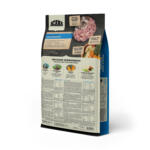Ensuring your dog has a comfortable and supportive place to rest is not just a luxury; it’s an essential component of their overall health and happiness. A good dog bed not only provides a cozy spot for your pet to relax but also supports their joints and can improve their sleep quality. Let’s explore how to find the ideal bed for your furry family member.
Understanding Your Dog’s Sleeping Habits
Observe your dog’s sleeping patterns to choose a bed that suits their preferences:
- Curlers: Dogs who love to curl up typically enjoy the security of a round or oval bed with raised edges. These beds provide a sense of enclosure and warmth, mimicking the feeling of being nestled in a safe, cozy den.
- Stretchers: For dogs who stretch out while sleeping, a rectangular, mattress-style bed is ideal. These beds allow enough space for your dog to lie flat, stretch their legs, and move around comfortably.
- Older Dogs: Aging dogs, or those with arthritis or joint issues, can greatly benefit from an orthopedic bed. These beds often feature memory foam which conforms to the dog’s body, providing superior support and relieving pressure on joints.
Size Matters: Finding the Right Fit
A bed that properly fits your dog’s size and weight is crucial:
- Measure Your Dog: To ensure the bed is large enough, measure your dog from nose to tail while they’re sleeping. Add a few inches to these measurements to account for movement and stretching.
- Consider Breed and Weight: Larger breeds need beds that can support their size and weight without collapsing. The bed should be sturdy enough to hold its shape over time, even with constant use.
Material and Durability: Balancing Comfort and Longevity
Selecting the right material is key for both comfort and durability:
- Comfort: A variety of materials are available for dog beds. Plush fabrics like fleece are warm and cozy, ideal for dogs that like to snuggle. For warmer climates, a lighter fabric like cotton may be more suitable.
- Durability: If your dog tends to chew or dig in their bed, look for a bed made with tough, durable materials. Some beds are designed with chew-resistant fabrics and reinforced seams.
- Easy to Clean: Consider a bed with a removable, machine-washable cover. Beds that are easy to clean ensure a hygienic sleeping environment for your pet.
Style Meets Functionality: Enhancing Your Home Aesthetics
A dog bed should fit seamlessly into your home:
- Design and Color: With the wide range of styles available, you can choose a bed that complements your interior design. Whether you prefer something sleek and modern or cozy and traditional, there’s a bed to match your taste.
- Placement: Think about where the bed will be located in your home. This can influence the size and style of the bed. A bed in the living room might need to be more stylish and compact, while a bed in a private corner can be more focused on comfort.
Health and Safety Bed Considerations
Your dog’s health and safety should be at the forefront:
- Hypoallergenic Materials: For dogs with allergies or sensitivities, hypoallergenic beds can prevent irritation and discomfort.
- Non-Slip Bottom: A non-slip base is essential for stability, preventing the bed from sliding, particularly on smooth surfaces.
- Quality Standards: Ensure the bed adheres to safety standards and is free from harmful chemicals and materials.
Frequently Asked Questions About Choosing the Right Dog Bed
Q: How do I know which size bed is best for my dog?
- A: Measure your dog from nose to tail while they’re sleeping and add a few inches to those measurements for the ideal bed length. This ensures they have enough room to stretch out and move comfortably without feeling cramped.
Q: What type of bed is recommended for a dog that chews?
- A: For chewers, look for beds labeled as ‘durable’ or ‘chew-resistant.’ These beds are often made with tougher materials and reinforced seams to withstand rougher treatment.
Q: How often should I clean my dog’s bed?
- A: It’s best to clean your dog’s bed regularly, ideally once a week. Beds with removable covers are easier to clean frequently. Regular cleaning helps eliminate odors and maintain a hygienic sleeping environment.
Q: Are elevated dog beds better than floor beds?
- A: Elevated beds offer better air circulation, keeping your dog cooler in hot weather. They can also be easier on the joints for getting on and off. However, some dogs may prefer the coziness of a traditional floor bed. It depends on your dog’s preferences and needs.
Q: Can a dog bed help with separation anxiety?
- A: A comfortable dog bed can provide a sense of security for your dog, which may help with mild separation anxiety. Beds that mimic a den-like environment, like cave beds or those with bolsters, can be particularly comforting.
Q: What’s the best way to transition my dog to a new bed?
- A: Introduce the new bed to your dog in a positive way. Place it in the same spot as their old bed, and encourage them to use it with treats or their favorite toys. Some dogs may take time to adjust, so patience is key.
Q: Is memory foam a good option for all dogs?
- A: Memory foam provides excellent support and is especially beneficial for older dogs, dogs with arthritis, or larger breeds. However, it can be quite firm, so some dogs might prefer a softer, plush bed.
Q: How do I choose a bed for a dog with allergies?
- A: Look for hypoallergenic dog beds made from materials that resist allergens. These beds are often easier to clean and made from fabrics less likely to irritate sensitive skin.
Selecting the perfect bed for your dog is a thoughtful way to cater to their comfort and health needs. By considering their sleeping style, size, the material of the bed, and your home aesthetics, you can ensure your dog enjoys a restful and rejuvenating sleep. A well-chosen bed is not just a resting place for your dog but a haven of comfort and security.







